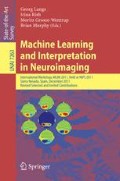Abstract
In this work we apply multivariate feature selection methods to construct a classifier that is able to differentiate among control subjects and OCD patients, with the purpose of bringing out regions of the brain that are relevant for the detection of the disease. Results show a discovery of regions that present great agreement with traditional methods used in OCD problems, but with the advantage of showing which ones are representative of control subjects or patients and providing cleaner and more accurate region maps.
This work was supported by grants Spain CICYT grant TEC2008-02473, Madrid Regional Government grant CCG10- UC3M/TIC-5511 and PASCAL2 Network of Excellence IST-2007-216886, and the Carlos III Health Institute (PI09/01331 and CP10/00604). Dr. Soriano-Mas is funded by a Miguel Servet contract from the Carlos III Health Institute (CP10/00604).
Access this chapter
Tax calculation will be finalised at checkout
Purchases are for personal use only
Preview
Unable to display preview. Download preview PDF.
References
Cox, D.D., Savoy, R.L.: Functional Magnetic Resonance Imaging (fMRI) ”brain reading”: detecting and classifying distributed patterns of fMRI activity in human visual cortex. Neuroimage 19(2), 261–270 (2003)
Wang, X., Hutchinson, R., Mitchell, T.M.: Training fMRI classifiers to discriminate cognitive states across multiple subjects. In: Thrun, S., Saul, L., Schölkopf, B. (eds.) Advances in Neural Information Processing Systems 16. MIT Press, Cambridge (2004)
Kamitani, Y., Tong, F.: Decoding the visual and subjective contents of the human brain. Nature Neuroscience 8(5), 679–685 (2005)
Haynes, J.D., Rees, G.: Predicting the orientation of invisible stimuli from activity in human primary visual cortex. Nature Neuroscience 8(5), 686–691 (2005)
LaConte, S., Strother, S., Cherkassky, V., Anderson, J., Hu, X.: Support vector machines for temporal classification of block design fMRI data. Neuroimage 26, 317–329 (2005)
Martínez-Ramón, M., Koltchinskii, V., Heileman, G.L., Posse, S.: fMRI pattern classification using neuroanatomically constrained boosting. Neuroimage 31(3), 1129–1141 (2006)
Ford, J., Farid, H., Makedon, F., Flashman, L.A., McAllister, T.W., Megalooikonomou, V., Saykin, A.J.: Patient Classification of fMRI Activation Maps. In: Ellis, R.E., Peters, T.M. (eds.) MICCAI 2003. LNCS, vol. 2879, pp. 58–65. Springer, Heidelberg (2003)
Shinkareva, S.V., Ombao, H.C., Sutton, B.P., Mohanty, A., Miller, G.A.: Classification of functional brain images with a spatio-temporal dissimilarity map. NeuroImage 33(1), 63–71 (2006)
Demirci, O., Clark, V.P., Calhoun, V.D.: A projection pursuit algorithm to classify individuals using fMRI data: Application to schizophrenia. NeuroImage 39(4), 1774–1782 (2008)
Castro, E., Martínez-Ramón, M., Pearlson, G., Sui, J., Calhoun, V.D.: Characterization of groups using composite kernels and multi-source fMRI analysis data: Application to schizophrenia. NeuroImage 58(2), 526–536 (2011)
Ecker, C., Rocha-Rego, V., Johnston, P., Mourão-Miranda, J., Marquand, A., Daly, E.M., Brammer, M.J., Murphy, C., Murphy, D.G.: Investigating the predictive value of whole-brain structural MR scans in autism: A pattern classification approach. NeuroImage 49(1), 44–56 (2010)
Costafreda, S.G., Chu, C., Ashburner, J., Fu, C.H.: Prognostic and diagnostic potential of the structural neuroanatomy of depression. PLoS ONE 4, 6353 (2009)
Pujol, J., Soriano-Mas, C., Alonso, P., Cardoner, N., Menchón, J.M., Deus, J., Vallejo, J.: Mapping structural brain alterations in obsessive-compulsive disorder. Arch. Gen. Psychiatry 61(7), 720–730 (2004)
Radua, J., Mataix-Cols, D.: Voxel-wise meta-analysis of grey matter changes in obsessive-compulsive disorder. The British Journal of Psychiatry 195(5), 393–402 (2009)
Soriano-Mas, C., Pujol, J., Alonso, P., Cardoner, N., Menchón, J.M., Harrison, B.J., Deus, J., Vallejo, J., Gaser, C.: Identifying patients with obsessive-compulsive disorder using whole-brain anatomy. NeuroImage 35(3), 1028–1037 (2007)
Bi, J., Bennett, K., Embrechts, M., Breneman, C., Song, M.: Dimensionality reduction via sparse support vector machines. J. Mach. Learn. Res. 3, 1229–1243 (2003)
Vapnik, V.: The nature of statistical learning theory. Springer, New York (1995)
Boser, B.E., Guyon, I., Vapnik, V.: A training algorithm for optimal margin classifiers. In: Computational Learing Theory, pp. 144–152 (1992), citeseer.ist.psu.edu/boser92training.html
Ashburner, J.: A fast diffeomorphic image registration algorithm. Neuroimage 38, 95–113 (2007)
Good, C.D., Johnsrude, I.S., Ashburner, J., Henson, R.N., Friston, K.J., Frackowiak, R.S.: A voxel-based morphometric study of ageing in 465 normal adult human brains. Neuroimage 14, 21–36 (2001)
Menzies, L., Chamberlain, S.R., Laird, A.R., Thelen, S.M., Sahakian, B.J., Bullmore, E.T.: Integrating evidence from neuroimaging and neuropsychological studies of obsessive-compulsive disorder: the orbitofronto-striatal model revisited. Neurosci. Biobehav Rev. 32(3), 525–549 (2008)
Guyon, I., Weston, J., Barnhill, S., Vapnik, V.: Gene selection for cancer classification using support vector machines. Machine Learning 46, 389–422 (2002)
Author information
Authors and Affiliations
Editor information
Editors and Affiliations
Rights and permissions
Copyright information
© 2012 Springer-Verlag Berlin Heidelberg
About this paper
Cite this paper
Parrado-Hernández, E. et al. (2012). Identification of OCD-Relevant Brain Areas through Multivariate Feature Selection. In: Langs, G., Rish, I., Grosse-Wentrup, M., Murphy, B. (eds) Machine Learning and Interpretation in Neuroimaging. Lecture Notes in Computer Science(), vol 7263. Springer, Berlin, Heidelberg. https://doi.org/10.1007/978-3-642-34713-9_8
Download citation
DOI: https://doi.org/10.1007/978-3-642-34713-9_8
Publisher Name: Springer, Berlin, Heidelberg
Print ISBN: 978-3-642-34712-2
Online ISBN: 978-3-642-34713-9
eBook Packages: Computer ScienceComputer Science (R0)

